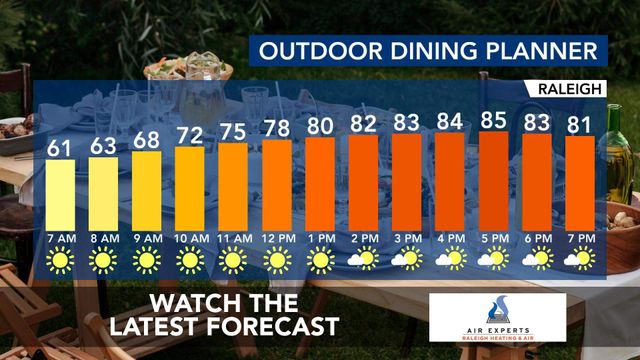How to gather safely this holiday season

This article was written for our sponsor, Campbell University School of Osteopathic Medicine.
Every holiday season millions of people make the trek across the state or country, seeking the homes of family and friends — and the weeks between Thanksgiving and Christmas see some of the highest year-round traffic both on the roads and in the sky.
This year, however, those travel plans may look a little different.
With the threat of COVID-19 still looming, many people are faced with the decision to recalibrate their holiday travel plans and forego seeing family in person.
"This year is going to be a challenging season, and it's not going to be like any other we've had before. When it comes to gathering, people are really going to have to look at the state of the number of infections and outbreaks wherever they'll be going," said Dr. Tiffany Lowe-Payne, an osteopathic physician, obesity medicine specialist, and assistant professor at Campbell University School of Osteopathic Medicine.
Lowe-Payne continued, "If you're finding that there are going to be a lot of different people from different places coming together, and you're not exactly sure if they are maintaining safe practices to decrease the risk of transmission, then you may want to reconsider gathering."
While many airlines have been doing what they can to reduce the risk — like blocking out seats and requiring masks for the duration of the flight — airports themselves can carry a host of germs from geographic regions across the country.
Since most methods of travel present at least a small chance of infection, the Center for Disease Control recommends people stick around home this year, only gathering with their immediate family.
Still, many people don't want to spend the holidays alone — luckily, technology affords alternative options. In Lowe-Payne's case, for example, her family is foregoing an in-person gathering and opting for a virtual celebration complete with a murder mystery game night. Others could consider an outdoor-only event if weather permits.
"A lot of times we sit in the house, eat, watch football and play games, but maybe this year instead of having it focused around the TV, take it outside," said Lowe-Payne. "If you can, go outside and play some games that are outdoors. Not being indoors will limit the amount of time that people are in close contact and help potentially reduce risk."
For those who still choose to meet with their families in person and indoors, there are some precautions medical professionals recommend in order to make the gathering as safe as possible.
First, Lowe-Payne recommended gathering in a large space with proper ventilation. If the space doesn't have HEPA filters or air purifiers, then keeping windows open and limiting the number of people indoors can help keep the environment as germ-free as possible. For those with states that have limited gatherings to a certain number, individuals should abide by those rules.
When it comes to in-person holiday celebrations, one of the big questions on everyone's mind is to test or not to test. The short answer? It certainly doesn't hurt.
"It depends on what testing capacity your area has, but ideally if you're going to be together with family members, it would be best to test beforehand. That's more important than anything else because you want to try to identify those who are at-risk and keep them safe," said Dr. Nicholas Pennings, director of the Campbell University Health Center and Chair of Family Medicine.
Pennings continued, "You certainly need to be careful about getting together with individuals who are high-risk. Elderly family members, family members with severe diseases like diabetes, those with obesity — they're all risk factors that can complicate the infection, so for those individuals, it may be best to avoid gatherings."
While Pennings and Lowe-Payne both agreed virtual gatherings are likely the safest option this year, those who choose to gather in-person should take certain measures in addition to pre-testing and limiting the number of guests. Doing so will preserve the healthy of family and friends as much as realistically possible.
"Masks can help to save lives, so I would highly recommend that you do wear masks, even if you're indoors and know the other people that you're with. COVID doesn't discriminate, and in these small gatherings where people let their guard down and take the masks off, we're seeing those as some of the ways that COVID is spreading at this time," said Lowe-Payne.
Lowe-Payne added, "Of course, make sure that you are washing your hands or sanitizing, as well as frequently disinfecting common areas. Maybe change it up a little bit and focus on disposable items, disposable hand towels in your bathroom and disposable plates and cups that are single-serve use only and can limit the amount of people who may be touching it."
Lowe-Payne also suggested avoiding buffet-style eating, instead having one mask-wearing person serve up the food to reduce contact. When it comes to sitting down to eat, however, people will have to take their masks off. While this complicates things, sitting outside or in different spaced out areas of the home can help reduce risk.
Still, when gathering in person and taking off masks, it's nearly impossible to totally eliminate risk.
"This virus is spread by droplets, so the biggest concern that we see is eating together and engaging in conversation. You're going to be admitting respiratory particles that can potentially carry the virus when you're conversing near someone, and I don't know that six feet is even enough if you're going to be in an unmasked situation," said Pennings. "There are some that suggest that you might need to be 12 feet apart, which would make it very hard to carry out a conversation if everybody's 12 feet apart. Those conversations would be better had with masks on and online."
Deciding whether or not to gather with family for the holidays is no easy decision, especially in a year that's been trying for so many. For those who eagerly anticipate yearly traditions or are only able to see family around the holiday season, the upcoming weeks hold some tough decisions.
But, as Lowe-Payne and Pennings emphasized, foregoing an in-person gathering doesn't mean you have to forego gathering altogether. By bringing a little creativity to the celebration, friends and family can still enjoy spending the holidays together and ensure their health and safety at the same time.
"We can be really creative about the ways to be able to spend time with our loved ones, and virtual platforms are really key in being able to connect with those that we love and enjoy the holidays safely," said Lowe-Payne. "Being socially distanced and making sure that we're socially responsible does not require us to be socially isolated."
This article was written for our sponsor, Campbell University School of Osteopathic Medicine.











